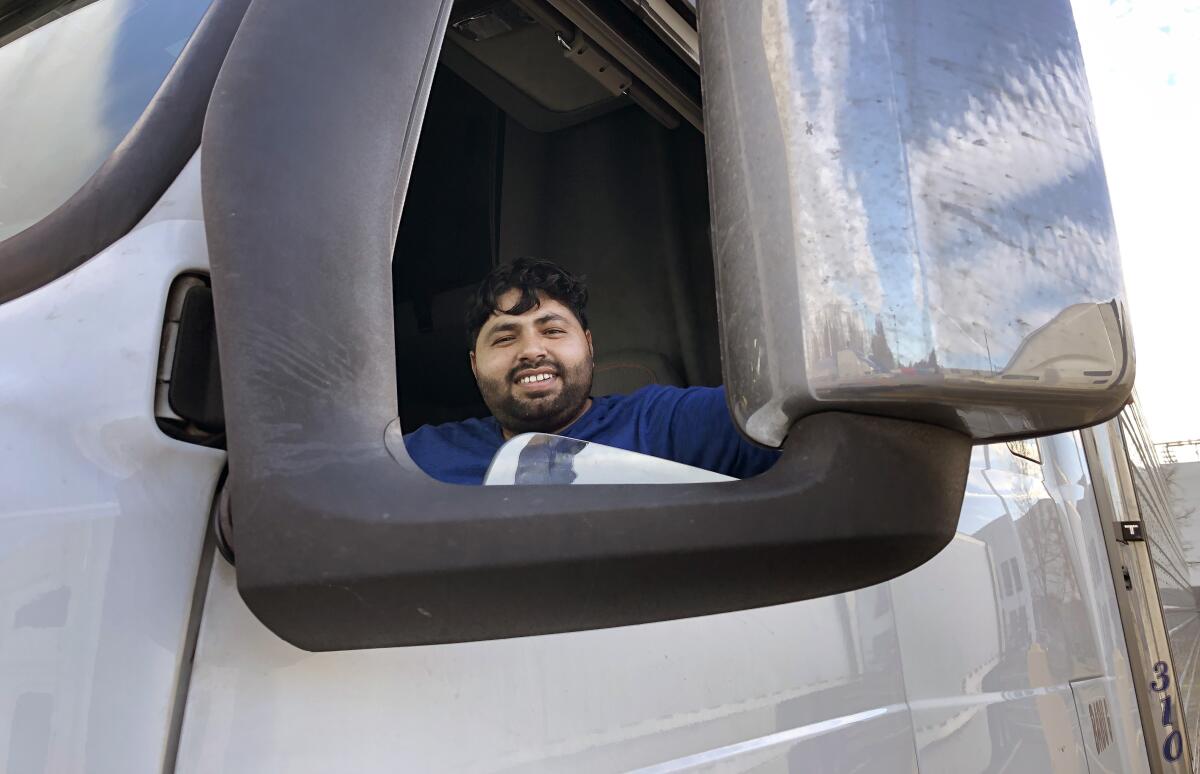Facing record labor shortages, trucking firms battle fiercely for drivers

- Share via
COLUMBIA, S.C. — Dawn hasn’t broken when Jerrett Sellers spots a promising target in the mostly deserted streets of South Carolina’s capital: a lone truck driver climbing down from his cab at a gas station.
Sellers looks for encouraging signs. Shoulders slumped with fatigue? A clean and tidy appearance? Liking what he sees, Sellers moves quickly, approaching the driver with a piece of paper in his hand.
“You got a quick sec to talk?” he calls to the man. “We’re looking to hire.”
Sellers, 32, is a front-line soldier in the nationwide battle to combat a shortage of truck drivers that has become a serious problem for the U.S. economy as it struggles against the seemingly endless assaults of the COVID-19 pandemic.
As transportation manager for Merchants Foodservice, a regional trucking and delivery firm based in Hattiesburg, Miss., Sellers hunts service stations, convenience stores, truck stops, driving schools, and wherever else he might find potential recruits, even as his competitors are doing the same to lure away his firm’s drivers.
Sellers’ pitch includes $2,000 signing bonuses, medical and dental coverage, and even an extra $125 a week just for showing up on time.

Earlier this year, Sellers followed one driver hauling a 28-foot trailer to a golf course and ended up courting him for weeks. They talked about their children, about softball and about Merchants Foodservice’s emphasis on “family values.” The driver finally agreed to jump ship.
A global supply chain breakdown has resulted in gridlock at the ports of Los Angeles and Long Beach and beyond.
Experiences like that have taught Sellers patience. His latest pre-dawn approach at the gas station was not an immediate success. The driver, sporting a new Apple watch and Bluetooth earbuds, said he’d already gotten fat raises this year, the equivalent of $4 an hour. “I’m comfortable,” the driver said.
Sellers handed him a business card anyway.
Nationwide, the competition for drivers has led industry giants to resort to extreme measures: unprecedented pay increases and benefits, signing bonuses as high as $20,000, and posh new truck terminals that include masseurs, basketball gyms and rec rooms.
“I’ve seen where they have put in gorgeous tile showers that rival five-star hotel suites,” said Meg Larcinese, national sales manager at the Trucker Media Group, which helps develop recruiting strategies for trucking firms.
Even so, no one in the industry sees an easing any time soon of what has become a historic shortage of drivers — some 80,000, by estimates from the American Trucking Assns.

While the backup at the ports in Los Angeles County and elsewhere has been a big focus for the Biden administration, trucks carry more than 70% of domestic cargo shipments.
The driver shortage is a major factor in the supply chain gridlock, mucking up delivery of all kinds of freight. It’s contributed to surging inflation, and created delays and product shortages that are making the holiday season less than cheery for consumers.
The root of the problem is the pandemic, which temporarily knocked out production and shipments last year even amid rising demand from homebound Americans. Like many other workers, truck drivers have been slow to return to their jobs, and the arrival of the Omicron variant may add to the hesitation.
Mere weeks after a group of port truck drivers voted to unionize, they opened their mailboxes to find termination notices from their employer. That letter was a violation of federal labor law, a judge ruled Tuesday.
But the trucking industry’s labor troubles run far deeper. At a time when the whole American population is aging, truck drivers tend to be older than average. The work is stressful, lonely, exhausting and long plagued by a pay system that can make drivers feel they can’t get ahead of the game.
Even before the pandemic, the industry’s turnover rate of around 90% was higher than in the notoriously volatile retail sector. Long-haul drivers are usually on the road two to three weeks straight. Burnout is high. So is retirement. Not enough young people are coming in to replace them.
Truck drivers are typically paid by the mile. Many complain their time isn’t valued by shippers and warehouses as they’re often subjected to long waits for freight to be loaded and unloaded. Finding someplace safe to park to rest or sleep for the night is a perennial worry. Nor do truckers find a lot of sympathy from state troopers, some of whom will ticket them for the slightest of violations, like missing reflective tape on a mud flap.

“They need to quit treating us like second-class citizens. We’re sick of it,” said Joyce Brenny, founder and chief executive of Minnesota-based Brenny Transportation, which has a fleet of 100 trucks.
Yet for all the pressures that the pandemic has added, Brenny and others see the possibility of major changes improving the lot of truckers. A former long-haul driver herself, Brenny is hiring more women, who now make up 15% of her carriers, double the industry average.
Brenny’s 25-year-old firm also started paying its drivers for the time they spend waiting for freight, though drivers generally don’t get paid for the first two hours of wait, and compensation after that can be low.
One thing that has clearly improved is pay. Many trucking firms, including Merchants Foodservice, have already given out two substantial raises this year. In September, the trucking industry’s weekly pay for nonsupervisory workers averaged $1,118 — or about $58,000 a year — up 15% from the same month in 2019, according to payroll data collected by the Bureau of Labor Statistics.
Economists and recruiters say the actual average increase since the pandemic has probably been closer to 30% when taking into account the hundreds of thousands of independent drivers, whose ranks have swelled in the last 18 months. The number of trucking firms and individual carriers authorized by the Department of Transportation totaled 362,159 in October, up 38% from the end of 2019.
The comparable figure for California was up 44% to nearly 43,903.

One of the newer independents is Adeel Nadeem, a refugee from Pakistan who was formerly a company driver but went out on his own. Last year the Maryland resident borrowed the money to buy a new Volvo truck for $180,000. He’s already put 200,000 miles on it.
Nadeem won’t say how much he earns, only that “there’s money there.” These days independent carriers can comfortably net $80,000, even with the recent increase in diesel fuel costs. Like others, Nadeem bids for freight on the “spot market,” where the price per mile for truck transportation has been shattering records as shippers can’t get enough from their regular stable of larger carriers.
Nadeem hates the wasted time at warehouses. At one stop in Arizona last month, he had to wait seven hours, which meant he didn’t get rolling until 8 p.m. and had to drive through the night. Between that and having to deal with brokers — “they control us,” he says — Nadeem finds his work lucrative, but also constraining.
Brokers are the middlemen between shippers and truckers, assigning loads to independent drivers. And there are now 28,000 government-authorized brokers in trucking, 55% more than two years earlier.
“This is a gold prison,” Nadeem says, sitting in his white cab at a truck stop in Jessup, Md.
At 31, Nadeem is younger than most truckers. The average age of a worker in the trucking industry is 47, and about a third of long-distance drivers are 55 or older. As in other industries, trucking saw a lot of retirements and people quitting during the pandemic, which only added to trucking labor’s woes.
“Because of COVID and the age of drivers, you had a lot of guys get sick and say, ‘Forget it, I’m out of here,’” says John Husing, a longtime economist specializing in the Inland Empire.
At the same time, truck driving schools and state offices issuing commercial drivers’ licenses closed or shrank their hours during the pandemic, setting things back further. As of July, 640,445 people in California had commercial driver’s licenses, down about 5,000 from two years earlier, according to the Department of Motor Vehicles.
Truck driving schools are now running near capacity, said Rob Hatchett, president of Fleet Intel, which collects driver pay and other trucking data. And with earnings having risen 30% in many cases, he says, more people are jumping in or returning to trucking. “We’ve made it where it’s an attractive industry.”
Still, companies can’t hire drivers fast enough. There were a record 589,000 transportation and warehousing job openings in September, about double the average of the previous four years. Many are in trucking.
President Biden’s recently passed infrastructure bill included a pilot program to lower the minimum age of interstate truck drivers to 18 from 21, which will help the industry target young people fresh out of high school. But the three-year test program is limited. It could add 32,000 new drivers a year at most, which won’t resolve the shortage anytime soon, said Avery Vise, vice president of trucking for FTR, a research and consulting firm.
And raising truckers’ pay has its offsets. It has drawn in more people, Vise said, but it’s also allowed drivers to take more days off, lowering the overall hauling capacity, which in turn pushes up prices for cargo and labor.
One of the giants of the industry, Prime Inc., has a fleet of 6,700 trucks and 9,000 drivers, and its efforts to get more drivers match its size. Recruiters call about 4,000 people every week. The calls typically yield 120 to 150 people who start training to be potential drivers, said Clayton Brown, a spokesman for the Springfield, Mo., firm.
Meanwhile, to keep drivers from leaving, Prime opened a new “amenities building” about a year ago at its terminal in Salt Lake City, its third in the country. The 60,000-square-foot building includes a full-sized gym, private sleeping rooms, doctor offices and even a pet-bathing station. (Many long-haul drivers, particularly women, have dogs that ride with them.) Brown says Prime’s turnover rate is under 50%, well below the industry average.
Mark Dolson, who’s been driving for 33 years, the last eight at Prime, said he regularly visits the building’s spa and salon, spending $100 for a 90-minute massage from a licensed therapist. “My body isn’t as young as it used to be,” said the 59-year-old native of Portland, Ore., who leases a truck from Prime, partly because he’s not sure how long he can keep driving.
The amenities facility gives Dolson a better feeling about the company. “It makes it nice,” he says. He is divorced, and his partner on the road is a Siberian husky.
Merchants Foodservice, which is too small to match such efforts, tries to do more of the little things, including providing company shirts, caps and coffee mugs. Sellers, who lives in Augusta, Ga., tells long-haul drivers that if they work for Merchants, they can sleep in their own beds every night because the company’s routes are relatively short.
And he tries to sell them on the company’s personal touch and family values. He may share how Merchants gave him a lot of support and flexible time at work when his young son, Lucas, was stricken with leukemia.
“Whenever I see Andy [Mercier, the company president], the first thing he says is, ‘How’s our boy doing?’” says Sellers, 32, who grew up in a little town outside Rockford, Ill., and started delivery driving in his early 20s.
While the pay for parcel and local delivery drivers has gone up significantly, much of the action today is in long-haul trucking.

Brian Bielli, 48, had worked for five years hauling lumber and sheetrock locally in Oklahoma where he lives, making about $55,000 a year. In September, he left his job and joined a national long-distance trucking firm. He got a $1,500 signing bonus and expects he’ll make about $80,000 a year.
“I enjoy it. The kids are all grown up,” he said at a truck stop near Charlotte, N.C. Bielli rides with his wife, Raylene, who keeps him company, looking at Facebook and taking photos during the journeys across the country. As long as the pay stays high, he sees no need to make changes.
“The prices in the market are crazy,” he said. “I’m gonna drive until I can’t drive anymore.”
More to Read
Get the L.A. Times Politics newsletter
Deeply reported insights into legislation, politics and policy from Sacramento, Washington and beyond. In your inbox twice per week.
You may occasionally receive promotional content from the Los Angeles Times.












